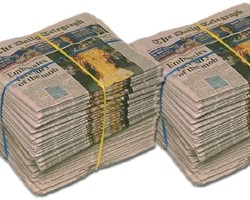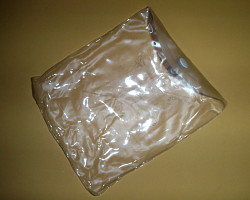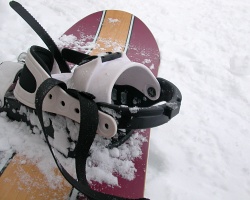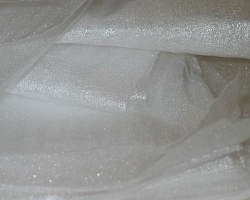How can I reuse or recycle plastic strapping?
 We’ve had an email from Amanda:
We’ve had an email from Amanda:
All 3 of my children are involved in paper routes here in Canada & as such we are left with 50+ plastic strappings twice a week. Our town says they are not recyclable & have to add to my already restricted garbage output. Whilst we are pushing the paper company to change the way they deliver & bundle the papers, we need to find ways to keep these strappings from the landfills.
I’ve never been enough of a morning person to have a paper route and I initially thought Amanda meant cable-tie-esque bindings but Google suggests they’re more like the straps I’ve seen around flat-pack furniture or the like – quite tough strips that are impossible to tear by hand but are reasonably flexible lengthwise. It is quite possibly polypropylene but I wouldn’t swear to that (just putting two and two together after reading a number of websites).
I’ve got a bit of a thing for weaving stuff like that so would be tempted to make them into a bag or something – but anyone else got any other suggestions?
























If you know anyone who sews (or have a school with a costume department nearby), they work great as boning in corsets, fitting bodices, and other tailored garments.
Could they be coiled into a hot plate, plant stand or coaster? A bit of strong glue at the very end and a clamp until it dried would probably do the trick. Depending on the colours, a bunch of them strung together could make for some cool (and durable) outdoor ornaments for the winter when the landscape it looking bleak.
You could use them to weave bags or waste paper baskets…
http://www.instructables.com/id/Packing-Strap-Bag/
woven into a placemat
Sure, glue in tight spirals using heavy duty glue and clamps, when dried glue or wire them together to make a trivet, a wall decoration, a boot mat outside your front door etc.
You could weave them into lawn chair seats!
Or weave them into firewood carriers
I work for a strap maker in Europe, and have to say it’s disappointing that your town will not recycle this strapping. It is polypropylene, which is normally 100% recyclable. Complain to them – other places worldwide are not so un-cooperative! Sadly, the idea of winding them and glueing them won’t work – PP is one of those shiny plastics that doesn’t glue well. Weaving can look cute though. The good news is that your 50 straps a week could be a light as, say 0.15Kg/week, less than 8Kg per year. This is why newspapers use them, as the most efficient and environmentally efficient way to secure these bundles of papers.
I’m the master recycler at PCI and wonder is there a eaisy way to chip/shred poly banding to reduce the volume? I have a company that will recycle – but want to reduce the space they take up. Thanks Alan
You can buy a strap chopper – they designed for steel strap, so they’re noisy and over specified for plastics. Try one of the big players like Samuel Strapping or Cyklop – they should be able to help you.
When I was in Japan for a work placement at a ski resort the Japanese girls women would fold these straps up into a woven goldfish. I wish I still had one to use as a template, they were a neat craft, I now work in the school district and wish I could find instructions so that I could teach the students how to make them, so they could learn a skill and to recycle at the same time. Sound familiar to any Nihon-jins (Japanese people) out there??
There was a craftsperson Lois Walpole who used to make baskets with them in the 90’s
She might have some images on her site
http://www.loiswalpole.com/
Look up strip folding or palm crafts to find out how to do the Vietnamese fish. (Scroll down to the ribbon fish)
http://www.origami-resource-center.com/strip-folding.html
I tie them up and toss them to my cats… they LOVE to chase them around and chew on them. lol
I have just started using them in my fascinators, can also be used as boning for corsets.
Also perfect if you trim to size for turning of the panic alarm on an alarm system at home or work.
You could use plastic strappings to weave fish or bangle/bracelet.
http://diyhowtodo.blogspot.com/2011/02/how-to-weave-fish-from-reused-paper.html
http://diyhowtodo.blogspot.com/2011/03/how-to-fold-or-weave-bracelet-from_101.html#axzz1IGzEsV9n
Weave to make a football or lamp shade. Cut into strips for plant labels. Make ideal handles for wooden flower containers – double end strap back thro. staples. Form a doom over plants to support netting.
Make hanging loops for tools hung from garage rafter nails. Weave to make a type of hanging basket. Spiral using heat to make plant stem supports. Kite making. Wind detector using upright section with magnet on end near reed switch. Hinges. Book marker. Spacer as when fitting double glazing windows or wall tiles. As per cable ties but staple. Woven to make seat for garden chair. Securing felt on shed felt. As a measuring ruler.
To use as a plant label punch holes to encode plant number using binary.
How to fasten plastic tape …. hold two pieces together with pliers making sure they touch … using fully hot soldering iron make holes through the two pieces of tap and allow 10 seconds for each to cool. Repeat across and along the tape with sufficient but not too many holes using pattern like number 5 on a dice.
To pull tape tight … make two loops in the ends of a piece of tape as above … flatten ends tape loops with pliers … using suitable string pull the tapes together using string-thro-holes progressively pulling string tighter … finish by using soldering iron holes as above … wedge two pieces of thin wood under tape to make a bridge to protect item being banded while soldering.
I was unable to pull a joint apart using all my strength.
Tip … be sure to always cut the tape in the best possible place for reuse. Perfect your technique on old pieces of tape first.
When making a cross-over connection make a number 5 pattern as on a dice.
If required weave thread in and out of soldered holes to strengthen joints.
This tape can readily be reshaped by immersion into boiling water for about 10 seconds and then cooling for a further 10 seconds.
Also if you need to pull any banding tighter … such as a band on a wooden made flower pot then boiling water will shrink the tape by 7 %
Also homemade hooks will carry quite a load such as a long coat.
To make a spiral wind tape onto a stick and tie each end of the tape … you will need help unless you have 4 hands. Pour boiling water over the arrangement (after letting go) and then cool in cold water. – remove tape and discard ends.
Another way of getting tape tight on a package is to use two ratchet tapes on either side of the tape prior to joining.
The ratchet tapes are the type used for securing loads on trailers and are mechanically pulled very tight providing a force of 100’s Newtons!
On plant labels pre-dip the cut tapes into different coloured match paint pots to encode the colour of plant or staple a piece of material in place or somehow use punched holes.
Tapes work well for de-flossing teeth.
Skids for sledges.
Water level indicator in tanks. Using a tape about 30 cm long … make a 90degree bend about 10 cm from end tape and secure to side of tank so that the remainder 20 cm overhangs the tank. With a piece of string suspend a light ball (able to float) at depth desired to be monitored. Add a suitable indicator to monitor bend of suspension tape.
Action: the bend or not bend of the tape will indicate the level of water in relation to the ball.
Modify by adding suitable weight below ball to prevent it rising very far when buoyant.
Repeat with other arrangements at different levels …could use a magnet on tape and static reed switch circuit to switch LED for remote monitoring. Instead of tank it could be a well.
Tried, tested and it works.
Putting up shelves:
Looking at shelf in cross section – height h and width w.
To make hanging bracket from tape. Measure length 20cm + h + w and make a 90degree bend clockwise using pliers … in another distance w a 90degree bend clockwise … in another distance h a 45degree bend clockwise … in another 1.41(w) distance another bend 45 degrees anticlockwise …. in another 20 cm bend the tape 180 degrees clockwise and cut the tape at a suitable place. On the doubled/tripled section of tape drill holes first then nail section to a vertical baton using a square washer to maintain the last but one bend made – more brackets – fit shelf.
Tapes for cycle clips, school pellet flicking (sorry teachers), wall paper scrapping, recoiling measuring tapes.